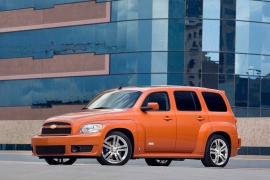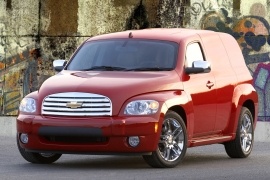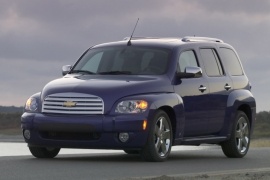CHEVROLET HHR Models/Series Timeline, Specifications & Photos
First production year: 2005
Engines: Gasoline, Natural gas
Body style: Van
Chevrolet upgraded the HHR lineup in 2006 with the introduction of a new, more powerful version that recalled the Super Sport badge from the company's heritage.
GM noticed an increased interest of its customers for more powerful vehicles in the mid-2000s and the HHR seemed to be a perfect candidate to receive more horses under the hood. Unlike any other tuning companies or custom car manufacturers, it started with the empty shell of an HHR, looked in the parts bin, and built a sportier version for it: the SS.
Chevrolet's designers made the HHR looks mean with a redesigned front grille that lost its horizontal slats. They placed a black mesh on it with a rhomboidal pattern, similar to the one used for the lower grille installed on the apron. The lower ground clearance and the 18" light-alloy wheels enhanced the car's sporty look. In the back, the car featured a sporty bumper with one side exhaust.
Inside, the carmaker installed new sport bucket seats with higher bolstering and red SS logos embroidered on the front seats' seatbacks. Just as a final reminder for the driver, the carmaker dropped the bow-tie badge from the steering wheel and replaced it with the SS badge.
Chevrolet developed the car's suspension on the Nurburgring race track in Germany. The two-liter turbocharged gasoline engine with direct fuel injection provided 265 hp, which helped the compact MPV get the promised hot-hatch performances its customers asked for.
The three letters from the HHR stood for Heritage High Roof, and the car was one of the most significant representatives of the retro-design theme that Chevrolet tried to use during the mid-2000s.
Built on top of the new Delta platform shared with the Chevrolet Cobalt and the Saturn Ion, the HHR tried to be bold in design and also provide the advantages of an MPV combined with those of a station wagon. The result was surprisingly good, but the car eventually fell victim to the world financial crisis and was withdrawn from the market in 2011 after just six years on the production lines.
With a design inspired by the 1947 Chevrolet Suburban, the HHR sported a clamshell hood design that incorporated the chromed, slatted grille. Its broader and lower fenders featured squared headlights. The high-roof cabin was designed, in the past, for those who wore hats, not baseball caps. In the rear, its dual taillights were rounded and mounted lower on the D-pillars. Unlike its passenger version, the panel van featured windows only for the front doors.
Inside, the HHR offered a modern design, with bucket seats and a molded dashboard. Its curves resembled, somehow, the older Chevrolets, but its instrument cluster was new. It even featured a center stack for the sound system and a center console. There were no rear seats and only a cavernous cargo space fit for those who wanted to carry stuff in style.
Unusually, even if the HHR Panel Van was designed as a utility vehicle, it was offered with a peppy turbocharged inline-four that sent almost 200 ponies to the front wheels via a five-speed manual.
At the beginning of the 2000s, the retro-design fever caught-on, and Chevrolet's design department turned its eyes on the cars from the '40s. The result was the Chevrolet High Heritage Roof or HHR for short.
After the biodesign era ended and customers started to look at different design languages, Chrysler and Chevrolet tried a different approach: a retro-design look built on a new platform. The HHR was a good example, but unfortunately, the carmaker installed the wrong engines in it. On top of that, just a few years later, the automotive industry collapsed under the world financial crisis. As a result, the HHR range died without a successor.
The HHR was an excellent example of inspiration from the past design models. The flat grille with horizontal slats resembled the grilles from the third generation of the Chevrolet Suburban. That art-deco style was charming for those times, and it could still stir some emotions on the market. Its broader and lower fenders featured squared headlights. The high roof cabin was designed, in the past, for those who wore hats, not baseball caps. In the rear, its dual taillights were rounded and mounted lower on the D-pillars.
Inside, the HHR offered a modern design, with bucket seats and a molded dashboard. Its curves resembled, somehow, the older Chevrolets, but its instrument cluster was new. It even featured a center stack for the sound system and a center console. The separate armrests for the driver and the front passenger was still a thing from the past.
Despite its charming design, the HHR sales were low in Europe. The carmaker installed only gasoline engines in an era when the diesel engine was the new king. Moreover, its 2.2-liter and 2.4-liter versions suffered from higher taxes.


